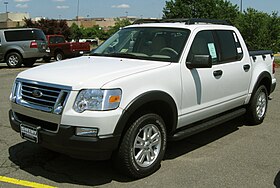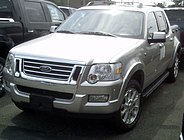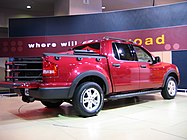
The Chevrolet Avalanche is a four-door, five- or six-passenger pickup truck that was manufactured by General Motors. The Avalanche was a hybrid between the Chevrolet Suburban SUV and the Chevrolet Silverado pickup truck, sharing the chassis with the Suburban. Unlike a typical pickup truck where the bed is mounted separately from the cab on the frame, the bed of the Avalanche was integrated with the cab body. It also featured a "midgate" behind the second row of seats that could be folded down, with the seats, to create a longer bed area. The Avalanche was produced across two generations starting in 2001 and ending in 2013.

The Ford Explorer is a range of SUVs manufactured by Ford Motor Company since the 1991 model year. As the first four-door SUV produced by Ford, the Explorer was introduced as a replacement for the two-door Bronco II. Within the current Ford SUV range in North America, the Explorer is slotted between the Ford Edge and Ford Expedition. As with the Ford Ranger, the Explorer derives its name from a trim package previously offered on the Ford F-Series pickup trucks.

The Mercury Mountaineer is a mid-size luxury sport utility vehicle (SUV) that was sold by Mercury from 1996 until 2010. Sharing many of its features with the Ford Explorer, the vehicles were virtually identical in terms of hardware. Externally, they were styled somewhat differently, and the Mountaineer was positioned with a more upscale interior, with the Mountaineer's MSRP coming in at $1,000–$6,000 more than the Explorer. It was last redesigned for the 2006 model year with a new frame, looking very similar to its previous model.

The Ford F-Series is a series of light-duty trucks marketed and manufactured by Ford Motor Company since the 1948 model year. The F-Series is marketed as a range of full-sized pickup trucks positioned above the midsize Ranger but below the larger Super Duty in the Ford truck lineup. Alongside the F-150, the F-Series also includes the Super Duty series, which includes the heavier-duty F-250 through F-450 pickups, F-450/F-550 chassis cabs, and F-600/F-650/F-750 Class 6–8 commercial trucks.

The Ford Excursion is a heavy-duty SUV that was sold by Ford Motor Company from 2000 to 2005. At the time of its introduction, the Excursion was the longest and heaviest SUV ever to enter mass production. The third Ford SUV derived from the F-Series pickup trucks, the model line used a heavier-duty chassis and frame than the Expedition; both vehicles competed against the Chevrolet Suburban.

The Ford Ranger is a range of pickup trucks manufactured and marketed by Ford Motor Company in North and South America under the Ford Ranger nameplate. Introduced in early 1982 for the 1983 model year, the Ranger is currently in its fourth generation. Developed as a replacement for the Mazda-sourced Ford Courier, the model line has been sold across the Americas; Ford of Argentina began production of the Ranger for South America in 1998.

The Ford Bronco is a model line of SUVs manufactured and marketed by Ford. The first SUV model developed by the company, five generations of the Bronco were sold from the 1966 to 1996 model years. A sixth generation of the model line was introduced for the 2021 model year. The nameplate has been used on other Ford SUVs, namely the 1984–1990 Bronco II compact SUV and the 2021 Bronco Sport compact crossover.

The Ford Super Duty is a series of heavy-duty pickup trucks produced by the Ford Motor Company since the 1999 model year. Slotted above the consumer-oriented Ford F-150, the Super Duty trucks are an expansion of the Ford F-Series range, from F-250 to the F-600. The F-250 through F-450 are offered as pickup trucks, while the F-350 through F-600 are offered as chassis cabs.

The twelfth generation of the Ford F-Series is a light-duty pickup truck that was produced by Ford from the 2009 to 2014 model years. Initially slotted between the Ford Ranger and Ford Super Duty in size, the F-150 became the smallest Ford truck in North America following the 2011 withdrawal of the Ranger. The final generation of the F-150 produced with a separate body design from the Super Duty trucks, the twelfth generation again adopted an all-new chassis and body, also marking an extensive transition to the powertrain lineup.

The fifth generationof the Ford F-Series is a line of pickup trucks and commercial trucks that were produced by Ford from the 1967 to 1972 model years. Built on the same platform as the fourth generation F-Series, the fifth generation had sharper styling lines, a larger cab, and expanded engine options.

The sixth generation of the Ford F-Series, also known as the "dentside Ford" to enthusiasts, is a line of pickup trucks and medium-duty commercial trucks that were produced by Ford Motor Company from the 1973 to 1979 model years. Produced by Ford in North America, Argentina, and Australia, this is the third and final generation of trucks derived from the 1965 Ford F-Series.
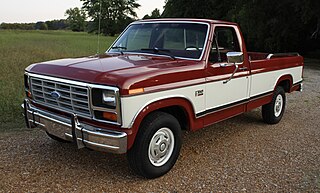
The seventh generation of the Ford F-Series is a range of trucks that was produced by Ford from the 1980 to 1986 model years. The first complete redesign of the F-Series since the 1965 model year, the seventh generation received a completely new chassis and body, distinguished by flatter body panels and a squarer grille, earning the nickname "bullnose" from enthusiasts. This generation marked several firsts for the model line, including the introduction of the Ford Blue Oval grille emblem, the introduction of a diesel engine to the model line, and a dashboard with a full set of instruments (optional). Conversely, this generation marked the end of the long-running F-100, the Ranger trim, and sealed-beam headlamps.

The ninth generation of the Ford F-Series is a lineup of trucks that were produced by Ford from the 1992 to 1998 model years. The final generation of the F-Series to include a complete range of trucks from a half-ton F-150 pickup truck to a medium-duty F-800 commercial truck, this is the third generation of the F-Series body and chassis introduced for 1980.
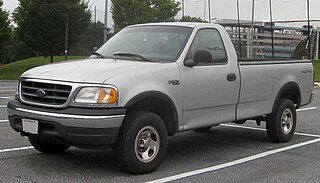
The tenth generation of the Ford F-Series is a line of pickup trucks produced by Ford Motor Company from the 1997 to 2004 model years. The first ground-up redesign of the F-Series since 1979, the tenth generation saw the introduction of an all-new chassis and a completely new body. In a significant model change, the tenth generation was developed only for the F-150, with the ninth-generation F-250 and F-350 replaced by the all-new Ford Super Duty variant of the F-Series for 1999. An all-new crew-cab configuration debuted in 1999 for the 2001 model year.

The eleventh generation of the Ford F-Series, marketed as the Ford Lobo in Mexico, is the company's line of light-duty pickup trucks manufactured and marketed by Ford for model years 2004-2008 — with a redesigned body and chassis, and marketed as its F-150 line, between the company's Ranger and the Super Duty trucks.

The thirteenth-generation Ford F-Series is a range of pickup trucks produced by Ford. Introduced for the 2015 model year, this generation of the F-Series is the first aluminum-intensive vehicle produced on a large scale by an American vehicle manufacturer. For the 2017 model year, the fourth-generation Super Duty line adopted the cab design of the F-150, consolidating the cab design for the first time on Ford light-duty trucks for the first time since the 1996 model year; the Super Duty trucks still retain separate bodywork and a heavier-duty frame.

The Raptor is a nameplate used by Ford for its "high-performance" pickup trucks and SUVs. In use since the 2010 model year, the Raptor is designated as the highest-performance version of the F-150, Ranger and Bronco. Drawing its name from both bird of prey and the velociraptor, the model line is intended as a street-legal counterpart of an off-road racing trophy truck. The F-150 Raptor is currently in its third generation; the Ranger Raptor was introduced in 2019 while the Bronco Raptor was released in late 2021.

The fourteenth-generation Ford F-Series is a range of pickup trucks produced by Ford, introduced for the 2021 model year. This was the first generation to include a fully-electric and hybrid pickup truck among the offerings, with the F-150 Lightning EV having entered production in 2022. The F-150 positioned above the midsize Ranger but below the larger Super Duty in the Ford truck lineup.

The fourth generation of the C/K series is a range of trucks that was manufactured by General Motors. Marketed by the Chevrolet and GMC brands from the 1988 to the 2002 model years, this is the final generation of the C/K model line. In a branding change, GMC adopted the GMC Sierra nameplate for all its full-size pickup trucks, leaving the C/K nomenclature exclusive to Chevrolet.

The Ford Maverick is a four-door, compact pickup truck manufactured and marketed by Ford Motor Company. It was unveiled on June 8, 2021, as Ford's smallest truck, slotted below the mid-size Ford Ranger.









